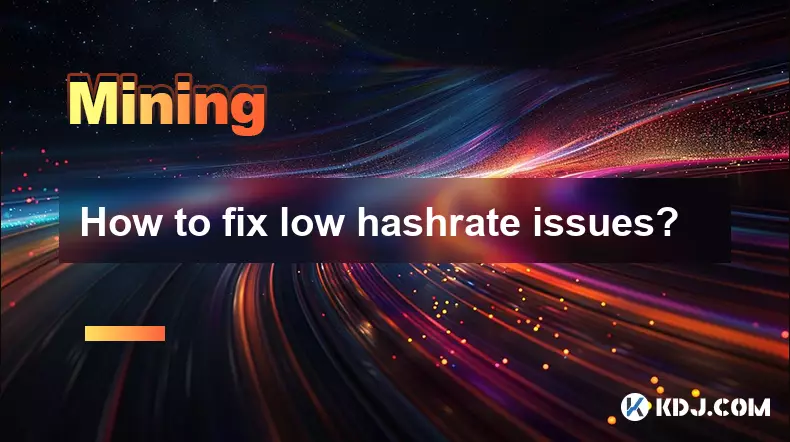-
 bitcoin
bitcoin $111145.080499 USD
0.75% -
 ethereum
ethereum $3928.989005 USD
1.66% -
 tether
tether $1.000226 USD
-0.02% -
 bnb
bnb $1108.209329 USD
-2.26% -
 xrp
xrp $2.545944 USD
6.36% -
 solana
solana $193.960655 USD
0.72% -
 usd-coin
usd-coin $1.000128 USD
0.02% -
 dogecoin
dogecoin $0.199304 USD
2.23% -
 tron
tron $0.297908 USD
-4.88% -
 cardano
cardano $0.656962 USD
2.13% -
 hyperliquid
hyperliquid $39.225782 USD
-1.92% -
 chainlink
chainlink $17.897108 USD
2.99% -
 ethena-usde
ethena-usde $0.999354 USD
-0.02% -
 stellar
stellar $0.321154 USD
3.36% -
 bitcoin-cash
bitcoin-cash $505.299839 USD
5.10%
How to fix low hashrate issues?
Outdated firmware, poor cooling, and incorrect BIOS settings can significantly reduce mining hashrate; regular updates, proper ventilation, and optimized configurations are essential for peak performance.
Oct 25, 2025 at 07:36 pm

Understanding the Causes of Low Hashrate
1. Outdated firmware on mining hardware can severely limit performance, leading to reduced hashrate across ASIC and GPU setups. Manufacturers regularly release updates that optimize power efficiency and computational throughput.
2. Poor thermal management causes throttling, where devices automatically reduce clock speeds to prevent overheating. Dust accumulation, inadequate airflow, or failing fans contribute significantly to temperature spikes.
3. Incorrect BIOS or overclocking settings on GPUs may result in suboptimal hash generation. Voltage curves, memory timings, and core clocks must be tuned precisely for maximum output without instability.
4. Power supply units operating below required wattage or delivering unstable voltage interfere with consistent miner operation. Ripple effects from low-quality PSUs can degrade performance across multiple rigs.
5. Network latency or connection drops between the miner and the pool server create submission delays, which appear as lower effective hashrate even if local computation remains strong.
Optimizing Hardware Configuration for Maximum Output
1. Update all firmware and drivers to the latest versions provided by the manufacturer. This includes ASIC control boards, GPU graphics drivers, and motherboard BIOS where applicable.
2. Clean mining rigs thoroughly using compressed air to remove dust from heatsinks, fans, and power supplies. Replace worn-out cooling components immediately to maintain thermal headroom.
3. Adjust undervolting profiles and memory offsets on GPUs through tools like MSI Afterburner or integrated miner interfaces. Aim for stability at high efficiency rather than chasing peak numbers.
4. Use high-efficiency, 80 Plus Gold or Platinum-rated PSUs with sufficient headroom—ideally 20% above total system draw—to ensure clean power delivery under continuous load.
5. Position rigs in well-ventilated areas with ambient temperatures below 28°C. Consider installing exhaust fans or dedicated cooling ducts in enclosed spaces.
Troubleshooting Software and Connection Problems
1. Verify that the mining software is correctly configured for the specific algorithm and hardware model. Misconfigured config files often lead to idle threads or rejected shares.
2. Switch to a geographically closer mining pool to minimize ping and reduce stale share rates. Some pools offer auto-location routing that improves consistency.
3. Monitor log outputs for recurring errors such as 'stratum connection lost' or 'difficulty reset.' These indicate network instability or incorrect authentication parameters.
4. Disable unnecessary background processes on mining OS instances. Lightweight Linux distributions like HiveOS or SimpleMiner reduce overhead and improve resource allocation.
5. Re-flash corrupted firmware or boot images using official recovery procedures. Corrupted NAND or SD cards are common culprits behind sudden hashrate drops.
Monitoring and Sustaining Performance Over Time
1. Implement real-time monitoring dashboards that track per-rig hashrate, temperature, fan speed, and power consumption. Tools like Awesome Miner or custom Grafana setups provide actionable insights.
2. Schedule weekly maintenance windows to inspect physical components, verify cabling integrity, and reapply thermal paste when necessary.
3. Keep spare parts inventory including fans, risers, and power connectors to minimize downtime during component failures.
4. Analyze historical performance data to detect gradual degradation trends before they become critical issues.
5. Enforce strict access controls on mining farm networks to prevent unauthorized configuration changes or cryptojacking attempts.
Frequently Asked Questions
What role does ambient temperature play in mining efficiency?Ambient temperature directly affects cooling capacity. High room temperatures reduce heat dissipation efficiency, forcing hardware to throttle sooner. Maintaining cooler environments allows sustained peak performance.
Can using multiple mining pools simultaneously improve results?Running failover configurations across pools enhances uptime but doesn’t increase raw hashrate. It ensures continuous mining during outages while maintaining consistent share submissions.
How often should I update my mining software?Check for updates every two weeks. Developers frequently patch bugs, add algorithm optimizations, and improve compatibility with new firmware releases.
Why does my rig show full hashrate during benchmark but lower output live?Benchmark tools measure ideal conditions without network dependency. Live mining involves constant communication with pool servers, and any delay in job retrieval or share submission reduces effective output.
Disclaimer:info@kdj.com
The information provided is not trading advice. kdj.com does not assume any responsibility for any investments made based on the information provided in this article. Cryptocurrencies are highly volatile and it is highly recommended that you invest with caution after thorough research!
If you believe that the content used on this website infringes your copyright, please contact us immediately (info@kdj.com) and we will delete it promptly.
- Essex Post Office, 5p Coins, and King Charles: A Royal Mint Revelation!
- 2025-10-23 10:30:16
- Waymo's Newark Airport AV Tests: Alphabet's AI Gamble Pays Off?
- 2025-10-23 10:30:16
- King Charles 5p Coins: A Royal Flush in Your Pocket?
- 2025-10-23 10:35:18
- Solana, Crypto Advisory, and Forward Industries: A New York Minute on the Future of Finance
- 2025-10-23 08:51:22
- MAGACOIN: Ethereum Whales Dive into the Hottest Presale of 2025
- 2025-10-23 08:51:22
- Kadena's End of the Road? KDA Token Plummets Amid Project Abandonment
- 2025-10-23 08:55:34
Related knowledge

How to set up a Chia (XCH) farming plot?
Oct 26,2025 at 03:20am
Understanding Chia Farming and Its Requirements1. Chia (XCH) operates on a unique consensus mechanism known as Proof of Space and Time, differing from...

How to use a VPN for crypto mining?
Oct 25,2025 at 06:01pm
Understanding the Role of a VPN in Crypto Mining1. A Virtual Private Network (VPN) creates an encrypted tunnel between your device and a remote server...

Is cloud mining a profitable investment?
Oct 25,2025 at 07:54pm
Understanding Cloud Mining in the Cryptocurrency Ecosystem1. Cloud mining allows individuals to participate in cryptocurrency mining without owning or...

How to connect multiple power supplies to one rig?
Oct 25,2025 at 10:36pm
Understanding Power Supply Configuration in Mining Rigs1. Connecting multiple power supplies to a single mining rig is common in cryptocurrency mining...

How to fix low hashrate issues?
Oct 25,2025 at 07:36pm
Understanding the Causes of Low Hashrate1. Outdated firmware on mining hardware can severely limit performance, leading to reduced hashrate across ASI...

A simple explanation of the Bitcoin mining process
Oct 21,2025 at 05:54am
What Is Bitcoin Mining?1. Bitcoin mining is the process by which new bitcoins are introduced into circulation and transactions are verified on the blo...

How to set up a Chia (XCH) farming plot?
Oct 26,2025 at 03:20am
Understanding Chia Farming and Its Requirements1. Chia (XCH) operates on a unique consensus mechanism known as Proof of Space and Time, differing from...

How to use a VPN for crypto mining?
Oct 25,2025 at 06:01pm
Understanding the Role of a VPN in Crypto Mining1. A Virtual Private Network (VPN) creates an encrypted tunnel between your device and a remote server...

Is cloud mining a profitable investment?
Oct 25,2025 at 07:54pm
Understanding Cloud Mining in the Cryptocurrency Ecosystem1. Cloud mining allows individuals to participate in cryptocurrency mining without owning or...

How to connect multiple power supplies to one rig?
Oct 25,2025 at 10:36pm
Understanding Power Supply Configuration in Mining Rigs1. Connecting multiple power supplies to a single mining rig is common in cryptocurrency mining...

How to fix low hashrate issues?
Oct 25,2025 at 07:36pm
Understanding the Causes of Low Hashrate1. Outdated firmware on mining hardware can severely limit performance, leading to reduced hashrate across ASI...

A simple explanation of the Bitcoin mining process
Oct 21,2025 at 05:54am
What Is Bitcoin Mining?1. Bitcoin mining is the process by which new bitcoins are introduced into circulation and transactions are verified on the blo...
See all articles










































































